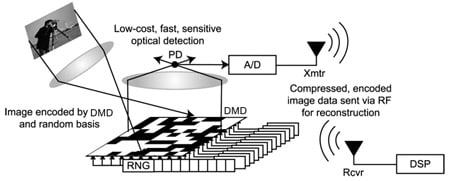Rice University Develops Single Pixel Camera for High Quality Photos
Rice University Develops Single Pixel Camera for High Quality Photos
Recommendations are independently chosen by Reviewed's editors. Purchases made through the links below may earn us and our publishing partners a commission.
January 23, 2007 – Call it impossible or just plain craziness, researchers at Rice University recently developed a prototype digital camera that can deliver high quality images with just a single pixel. As an alternative to traditional CCD or CMOS sensor designs, the single pixel camera uses a micromirror array and a process of compressive sensing.
Unlike standard digital cameras that use megapixels - millions of sensing detectors - the compressive sensing camera uses only one detector to sample light, and then it is combined with post-capture computations to reconstruct the image. The prototype was developed by Rice University's Electrical and Computer Engineering assistant professor Dr. Kevin Kelly and professor Dr. Richard Baraniuk. The prototype consists of two off-the-shelf lenses, a photodiode, and a micromirror array worth hundreds of dollars made by Texas Instruments, the official sponsor of the project.
The single pixel camera combines recent mathematics developed in the last few years with hardware construction available since January 2005. At the heart of this single pixel camera is the Texas Instruments-manufactured digital micromirror device (DMD),that replaces a traditional CCD array.
"Instead of a million detectors, we have a million micromirrors," said Kelly in an interview with DigitalCameraInfo.com.
Users may already be familiar with DMD since it is used as projectors in televisions, laptops, and digital cinema theatres. The two Rice professors used the concept of a projector in reverse, replacing the lamp with a photodiode and essentially making the DMD into a camera, said Baraniuk in an interview.

Each pixel is controlled by bouncing light with "on" and "off" mirrors, with an average measurement of 50 percent of light. Each measurement is randomized with a different percentage of "on" and "off" mirrors with each snapshot.
With the help of computer processing, the measurements are then converted to image pixels, reconstructing the photo using compression. Standard digital cameras use JPEG compression that is "wasteful," according to Baraniuk. Kelly said that JPEG compression is not ideal for certain types of images with high frequency information such as taking a photo of a rug with lots of edges.
The new compressive sensing camera, on the other hand, uses white noise compression. "White noise doesn’t have any bias towards certain images," said Kelly. This kind of universal compression, therefore, could better capture all types of images, both low and high frequencies. The ideal, according to the researcher, would be to see white noise compression used just like any other photo file format like JPEG or GIF files on Windows and Mac systems.
The single pixel camera does have some drawbacks. While capture is relatively quick, the post-capture calculations for pure random measurements can take up to days to process.
The mathematical algorithm involved in reconstructing the image from the randomized measurements is like solving a Sudoku puzzle, according to the researchers. With certain pre-specified table values, other combinations of values need to be plugged in like the puzzle game. The math behind this type of image reconstruction, however, requires input of every possible combination, making the process rather cumbersome and time-consuming.
In an effort to improve upon the prototype, the Rice researchers are working on permuted images, with only a select number of random measurements that should cut down the time of calculation significantly.
The prototype is "constantly evolving," said Kelly.
When asked how the single pixel, compressive sensing model could be improved, the Rice University researchers responded that more lenses could be added to create a high megapixel count panoramic camera.
The compressive sensing camera is more likely to have scientific and medical applications, such as MRI testing, according to the researchers. Because this camera requires fewer pixels, the camera could be an economic alternative to expensive equipment.
The compressive sensing cameras could also have Security applications, according to Baraniuk. By replacing the photo diode with a more sensitive diode for ultraviolet or infrared uses, the camera could be applied to airport security or military use.
"This is not going to replace the digital camera tomorrow," said Kelly. People can, however, imagine a day when a 40-megapixel camera could deliver a 100-megapixel image, said Baraniuk.
More information can be found at http://www.dsp.ece.rice.edu/cs/cscamera/.
Images courtesy of Rice University

